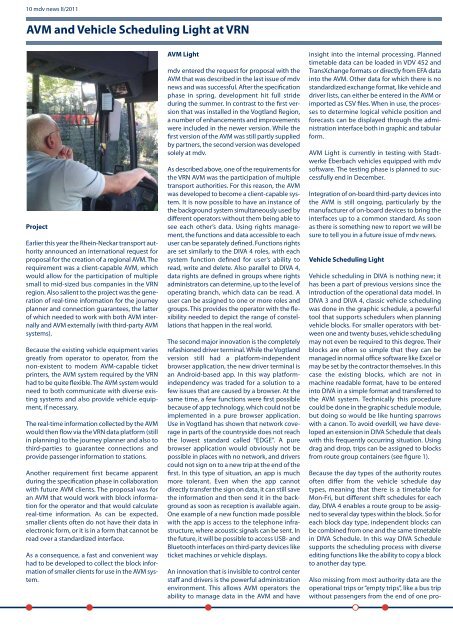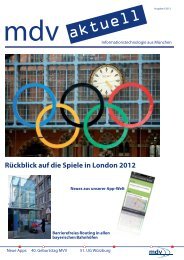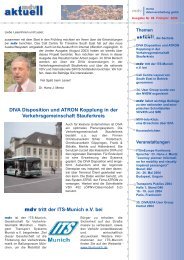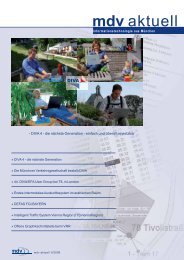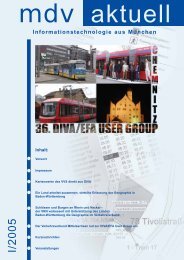DIVA 4 and EFA 10 - Paradigm Change at the VVS
DIVA 4 and EFA 10 - Paradigm Change at the VVS
DIVA 4 and EFA 10 - Paradigm Change at the VVS
Create successful ePaper yourself
Turn your PDF publications into a flip-book with our unique Google optimized e-Paper software.
<strong>10</strong> mdv news II/2011<br />
AVM <strong>and</strong> Vehicle Scheduling Light <strong>at</strong> VRN<br />
Project<br />
Earlier this year <strong>the</strong> Rhein-Neckar transport authority<br />
announced an intern<strong>at</strong>ional request for<br />
proposal for <strong>the</strong> cre<strong>at</strong>ion of a regional AVM. The<br />
requirement was a client-capable AVM, which<br />
would allow for <strong>the</strong> particip<strong>at</strong>ion of multiple<br />
small to mid-sized bus companies in <strong>the</strong> VRN<br />
region. Also salient to <strong>the</strong> project was <strong>the</strong> gener<strong>at</strong>ion<br />
of real-time inform<strong>at</strong>ion for <strong>the</strong> journey<br />
planner <strong>and</strong> connection guarantees, <strong>the</strong> l<strong>at</strong>ter<br />
of which needed to work with both AVM internally<br />
<strong>and</strong> AVM externally (with third-party AVM<br />
systems).<br />
Because <strong>the</strong> existing vehicle equipment varies<br />
gre<strong>at</strong>ly from oper<strong>at</strong>or to oper<strong>at</strong>or, from <strong>the</strong><br />
non-existent to modern AVM-capable ticket<br />
printers, <strong>the</strong> AVM system required by <strong>the</strong> VRN<br />
had to be quite flexible. The AVM system would<br />
need to both communic<strong>at</strong>e with diverse existing<br />
systems <strong>and</strong> also provide vehicle equipment,<br />
if necessary.<br />
The real-time inform<strong>at</strong>ion collected by <strong>the</strong> AVM<br />
would <strong>the</strong>n flow via <strong>the</strong> VRN d<strong>at</strong>a pl<strong>at</strong>form (still<br />
in planning) to <strong>the</strong> journey planner <strong>and</strong> also to<br />
third-parties to guarantee connections <strong>and</strong><br />
provide passenger inform<strong>at</strong>ion to st<strong>at</strong>ions.<br />
Ano<strong>the</strong>r requirement first became apparent<br />
during <strong>the</strong> specific<strong>at</strong>ion phase in collabor<strong>at</strong>ion<br />
with future AVM clients. The proposal was for<br />
an AVM th<strong>at</strong> would work with block inform<strong>at</strong>ion<br />
for <strong>the</strong> oper<strong>at</strong>or <strong>and</strong> th<strong>at</strong> would calcul<strong>at</strong>e<br />
real-time inform<strong>at</strong>ion. As can be expected,<br />
smaller clients often do not have <strong>the</strong>ir d<strong>at</strong>a in<br />
electronic form, or it is in a form th<strong>at</strong> cannot be<br />
read over a st<strong>and</strong>ardized interface.<br />
As a consequence, a fast <strong>and</strong> convenient way<br />
had to be developed to collect <strong>the</strong> block inform<strong>at</strong>ion<br />
of smaller clients for use in <strong>the</strong> AVM system.<br />
AVM Light<br />
mdv entered <strong>the</strong> request for proposal with <strong>the</strong><br />
AVM th<strong>at</strong> was described in <strong>the</strong> last issue of mdv<br />
news <strong>and</strong> was successful. After <strong>the</strong> specific<strong>at</strong>ion<br />
phase in spring, development hit full stride<br />
during <strong>the</strong> summer. In contrast to <strong>the</strong> first version<br />
th<strong>at</strong> was installed in <strong>the</strong> Vogtl<strong>and</strong> Region,<br />
a number of enhancements <strong>and</strong> improvements<br />
were included in <strong>the</strong> newer version. While <strong>the</strong><br />
first version of <strong>the</strong> AVM was still partly supplied<br />
by partners, <strong>the</strong> second version was developed<br />
solely <strong>at</strong> mdv.<br />
As described above, one of <strong>the</strong> requirements for<br />
<strong>the</strong> VRN AVM was <strong>the</strong> particip<strong>at</strong>ion of multiple<br />
transport authorities. For this reason, <strong>the</strong> AVM<br />
was developed to become a client-capable system.<br />
It is now possible to have an instance of<br />
<strong>the</strong> background system simultaneously used by<br />
different oper<strong>at</strong>ors without <strong>the</strong>m being able to<br />
see each o<strong>the</strong>r’s d<strong>at</strong>a. Using rights management,<br />
<strong>the</strong> functions <strong>and</strong> d<strong>at</strong>a accessible to each<br />
user can be separ<strong>at</strong>ely defined. Functions rights<br />
are set similarly to <strong>the</strong> <strong>DIVA</strong> 4 roles, with each<br />
system function defined for user’s ability to<br />
read, write <strong>and</strong> delete. Also parallel to <strong>DIVA</strong> 4,<br />
d<strong>at</strong>a rights are defined in groups where rights<br />
administr<strong>at</strong>ors can determine, up to <strong>the</strong> level of<br />
oper<strong>at</strong>ing branch, which d<strong>at</strong>a can be read. A<br />
user can be assigned to one or more roles <strong>and</strong><br />
groups. This provides <strong>the</strong> oper<strong>at</strong>or with <strong>the</strong> flexibility<br />
needed to depict <strong>the</strong> range of constell<strong>at</strong>ions<br />
th<strong>at</strong> happen in <strong>the</strong> real world.<br />
The second major innov<strong>at</strong>ion is <strong>the</strong> completely<br />
refashioned driver terminal. While <strong>the</strong> Vogtl<strong>and</strong><br />
version still had a pl<strong>at</strong>form-independent<br />
browser applic<strong>at</strong>ion, <strong>the</strong> new driver terminal is<br />
an Android-based app. In this way pl<strong>at</strong>formindependency<br />
was traded for a solution to a<br />
few issues th<strong>at</strong> are caused by a browser. At <strong>the</strong><br />
same time, a few functions were first possible<br />
because of app technology, which could not be<br />
implemented in a pure browser applic<strong>at</strong>ion.<br />
Use in Vogtl<strong>and</strong> has shown th<strong>at</strong> network coverage<br />
in parts of <strong>the</strong> countryside does not reach<br />
<strong>the</strong> lowest st<strong>and</strong>ard called “EDGE”. A pure<br />
browser applic<strong>at</strong>ion would obviously not be<br />
possible in places with no network, <strong>and</strong> drivers<br />
could not sign on to a new trip <strong>at</strong> <strong>the</strong> end of <strong>the</strong><br />
first. In this type of situ<strong>at</strong>ion, an app is much<br />
more tolerant. Even when <strong>the</strong> app cannot<br />
directly transfer <strong>the</strong> sign on d<strong>at</strong>a, it can still save<br />
<strong>the</strong> inform<strong>at</strong>ion <strong>and</strong> <strong>the</strong>n send it in <strong>the</strong> background<br />
as soon as reception is available again.<br />
One example of a new function made possible<br />
with <strong>the</strong> app is access to <strong>the</strong> telephone infrastructure,<br />
where acoustic signals can be sent. In<br />
<strong>the</strong> future, it will be possible to access USB- <strong>and</strong><br />
Bluetooth interfaces on third-party devices like<br />
ticket machines or vehicle displays.<br />
An innov<strong>at</strong>ion th<strong>at</strong> is invisible to control center<br />
staff <strong>and</strong> drivers is <strong>the</strong> powerful administr<strong>at</strong>ion<br />
environment. This allows AVM oper<strong>at</strong>ors <strong>the</strong><br />
ability to manage d<strong>at</strong>a in <strong>the</strong> AVM <strong>and</strong> have<br />
insight into <strong>the</strong> internal processing. Planned<br />
timetable d<strong>at</strong>a can be loaded in VDV 452 <strong>and</strong><br />
TransXchange form<strong>at</strong>s or directly from <strong>EFA</strong> d<strong>at</strong>a<br />
into <strong>the</strong> AVM. O<strong>the</strong>r d<strong>at</strong>a for which <strong>the</strong>re is no<br />
st<strong>and</strong>ardized exchange form<strong>at</strong>, like vehicle <strong>and</strong><br />
driver lists, can ei<strong>the</strong>r be entered in <strong>the</strong> AVM or<br />
imported as CSV files. When in use, <strong>the</strong> processes<br />
to determine logical vehicle position <strong>and</strong><br />
forecasts can be displayed through <strong>the</strong> administr<strong>at</strong>ion<br />
interface both in graphic <strong>and</strong> tabular<br />
form.<br />
AVM Light is currently in testing with Stadtwerke<br />
Eberbach vehicles equipped with mdv<br />
software. The testing phase is planned to successfully<br />
end in December.<br />
Integr<strong>at</strong>ion of on-board third-party devices into<br />
<strong>the</strong> AVM is still ongoing, particularly by <strong>the</strong><br />
manufacturer of on-board devices to bring <strong>the</strong><br />
interfaces up to a common st<strong>and</strong>ard. As soon<br />
as <strong>the</strong>re is something new to report we will be<br />
sure to tell you in a future issue of mdv news.<br />
Vehicle Scheduling Light<br />
Vehicle scheduling in <strong>DIVA</strong> is nothing new; it<br />
has been a part of previous versions since <strong>the</strong><br />
introduction of <strong>the</strong> oper<strong>at</strong>ional d<strong>at</strong>a model. In<br />
<strong>DIVA</strong> 3 <strong>and</strong> <strong>DIVA</strong> 4, classic vehicle scheduling<br />
was done in <strong>the</strong> graphic schedule, a powerful<br />
tool th<strong>at</strong> supports schedulers when planning<br />
vehicle blocks. For smaller oper<strong>at</strong>ors with between<br />
one <strong>and</strong> twenty buses, vehicle scheduling<br />
may not even be required to this degree. Their<br />
blocks are often so simple th<strong>at</strong> <strong>the</strong>y can be<br />
managed in normal office software like Excel or<br />
may be set by <strong>the</strong> contractor <strong>the</strong>mselves. In this<br />
case <strong>the</strong> existing blocks, which are not in<br />
machine readable form<strong>at</strong>, have to be entered<br />
into <strong>DIVA</strong> in a simple form<strong>at</strong> <strong>and</strong> transferred to<br />
<strong>the</strong> AVM system. Technically this procedure<br />
could be done in <strong>the</strong> graphic schedule module,<br />
but doing so would be like hunting sparrows<br />
with a canon. To avoid overkill, we have developed<br />
an extension in <strong>DIVA</strong> Schedule th<strong>at</strong> deals<br />
with this frequently occurring situ<strong>at</strong>ion. Using<br />
drag <strong>and</strong> drop, trips can be assigned to blocks<br />
from route group containers (see figure 1).<br />
Because <strong>the</strong> day types of <strong>the</strong> authority routes<br />
often differ from <strong>the</strong> vehicle schedule day<br />
types, meaning th<strong>at</strong> <strong>the</strong>re is a timetable for<br />
Mon-Fri, but different shift schedules for each<br />
day, <strong>DIVA</strong> 4 enables a route group to be assigned<br />
to several day types within <strong>the</strong> block. So for<br />
each block day type, independent blocks can<br />
be combined from one <strong>and</strong> <strong>the</strong> same timetable<br />
in <strong>DIVA</strong> Schedule. In this way <strong>DIVA</strong> Schedule<br />
supports <strong>the</strong> scheduling process with diverse<br />
editing functions like <strong>the</strong> ability to copy a block<br />
to ano<strong>the</strong>r day type.<br />
Also missing from most authority d<strong>at</strong>a are <strong>the</strong><br />
oper<strong>at</strong>ional trips or “empty trips”, like a bus trip<br />
without passengers from <strong>the</strong> end of one pro-


